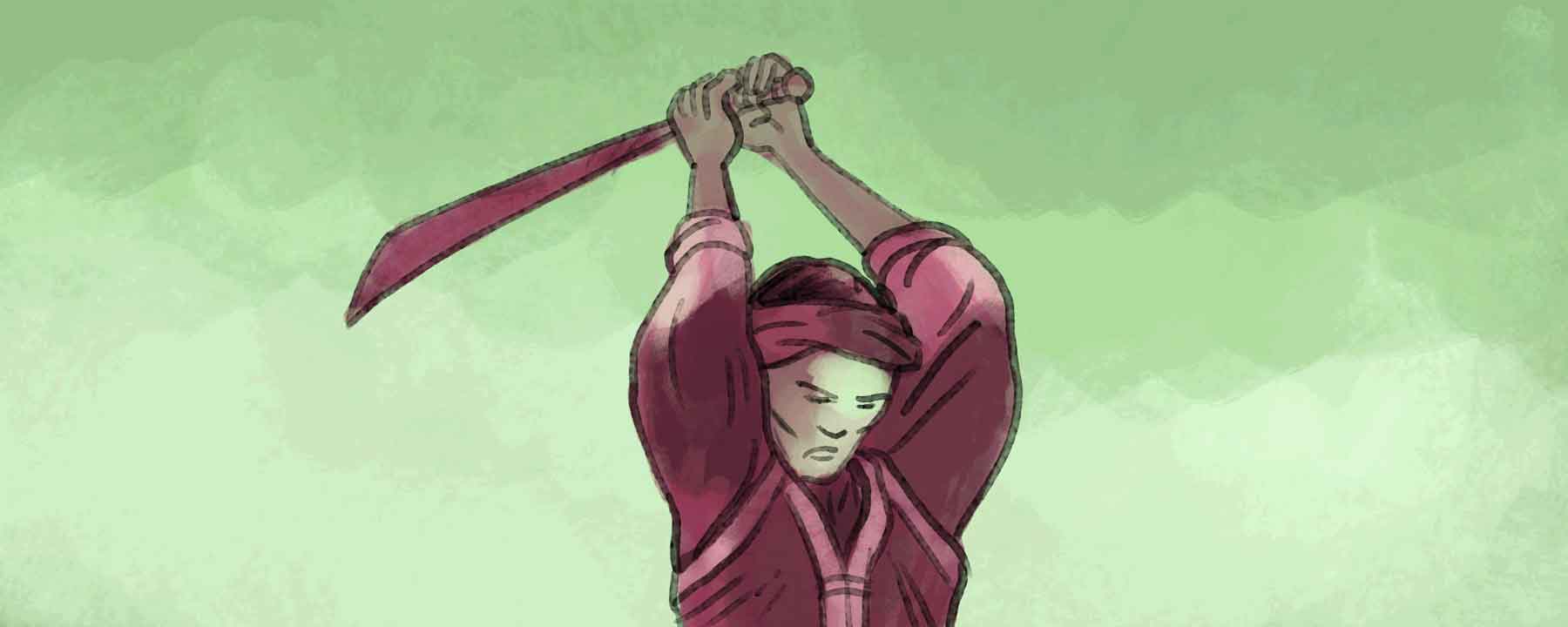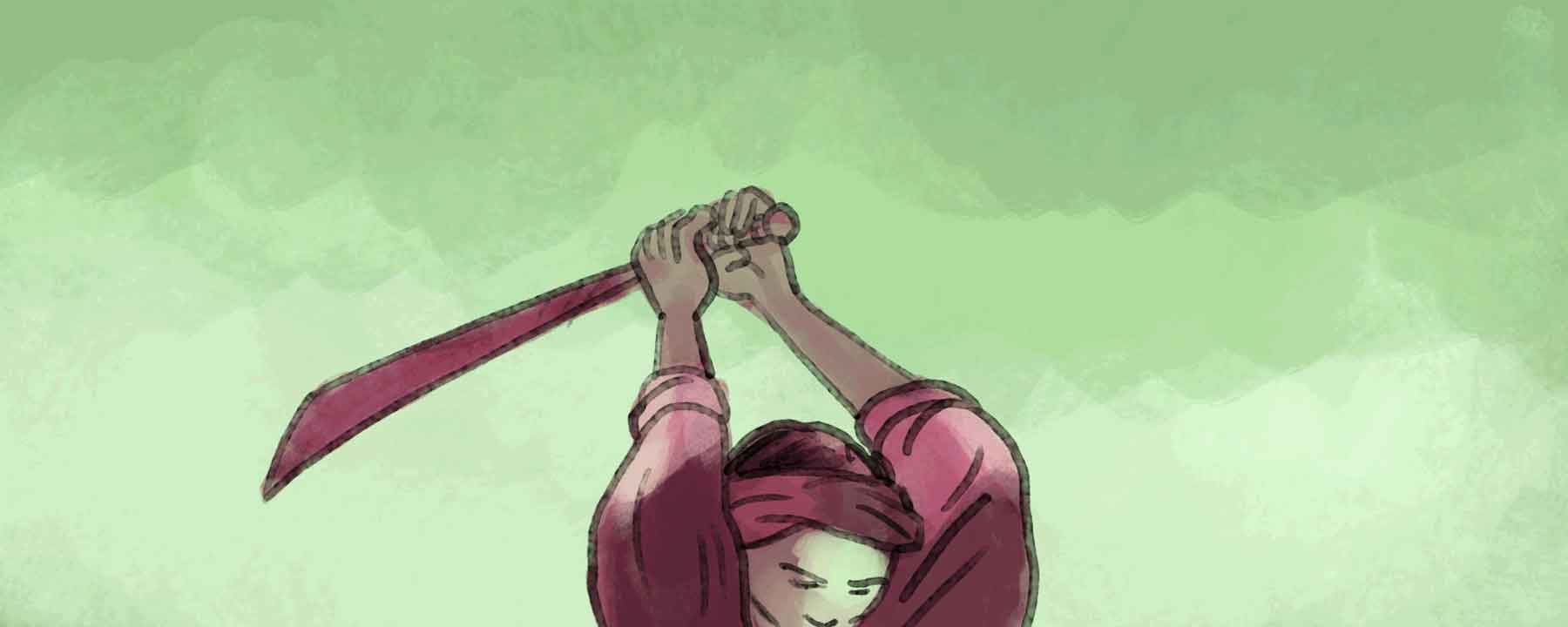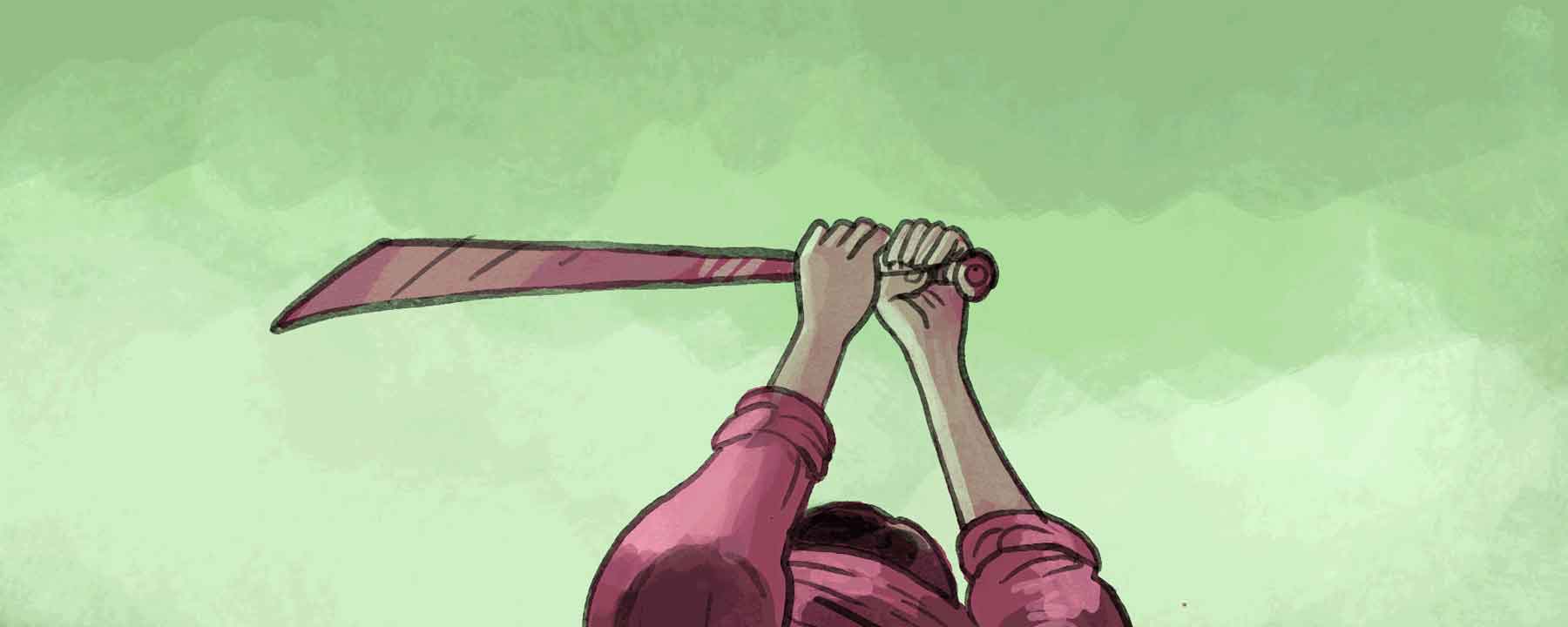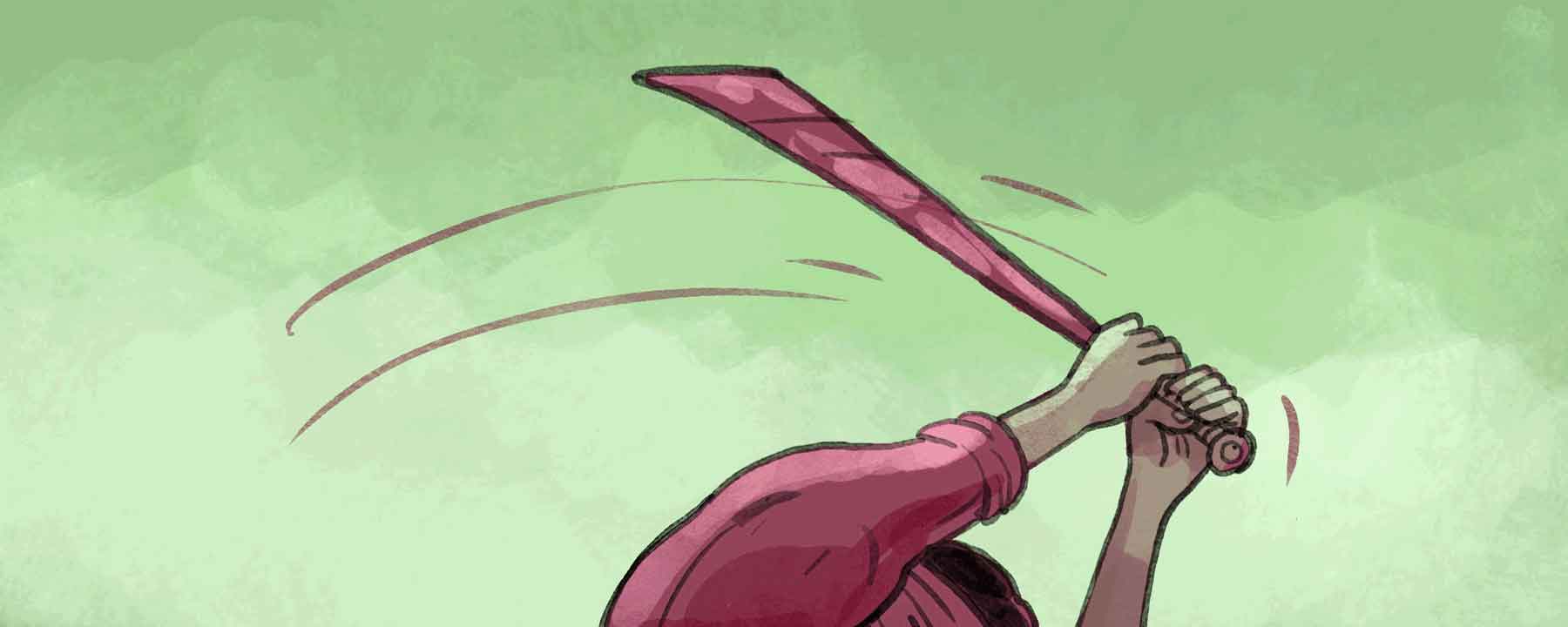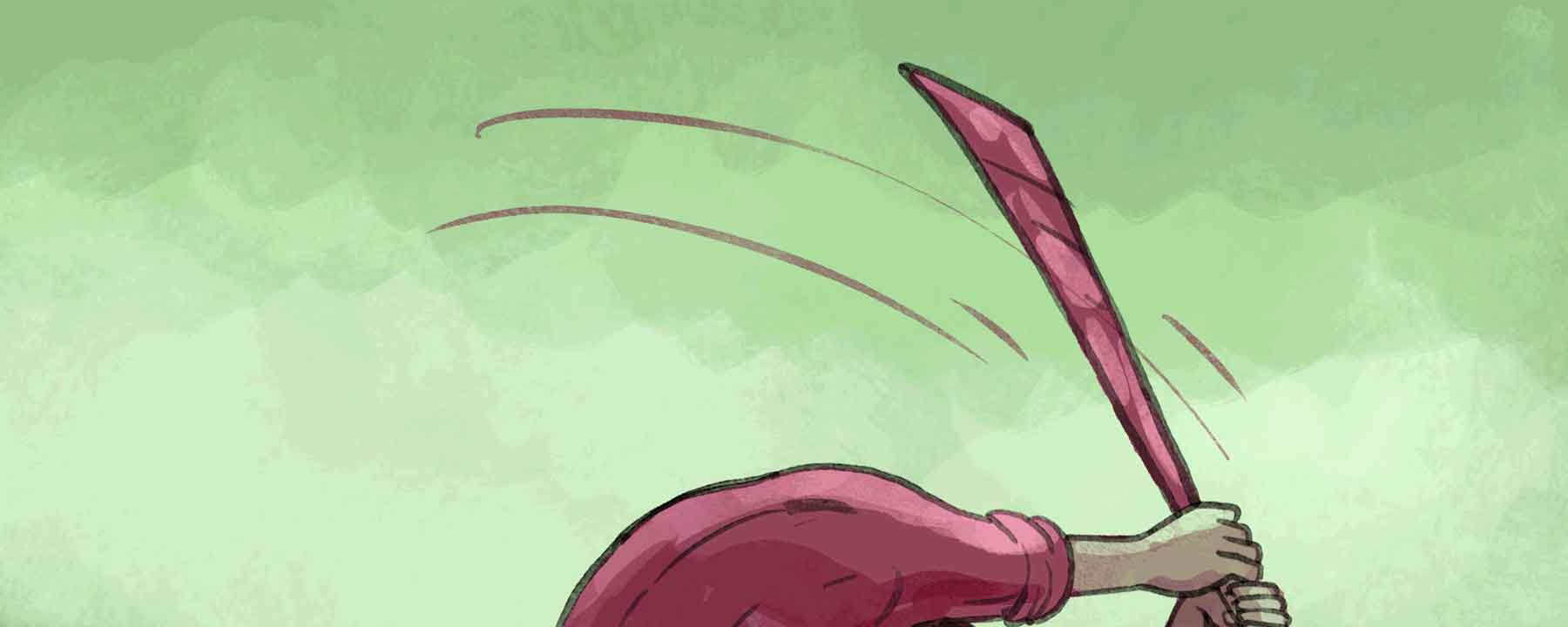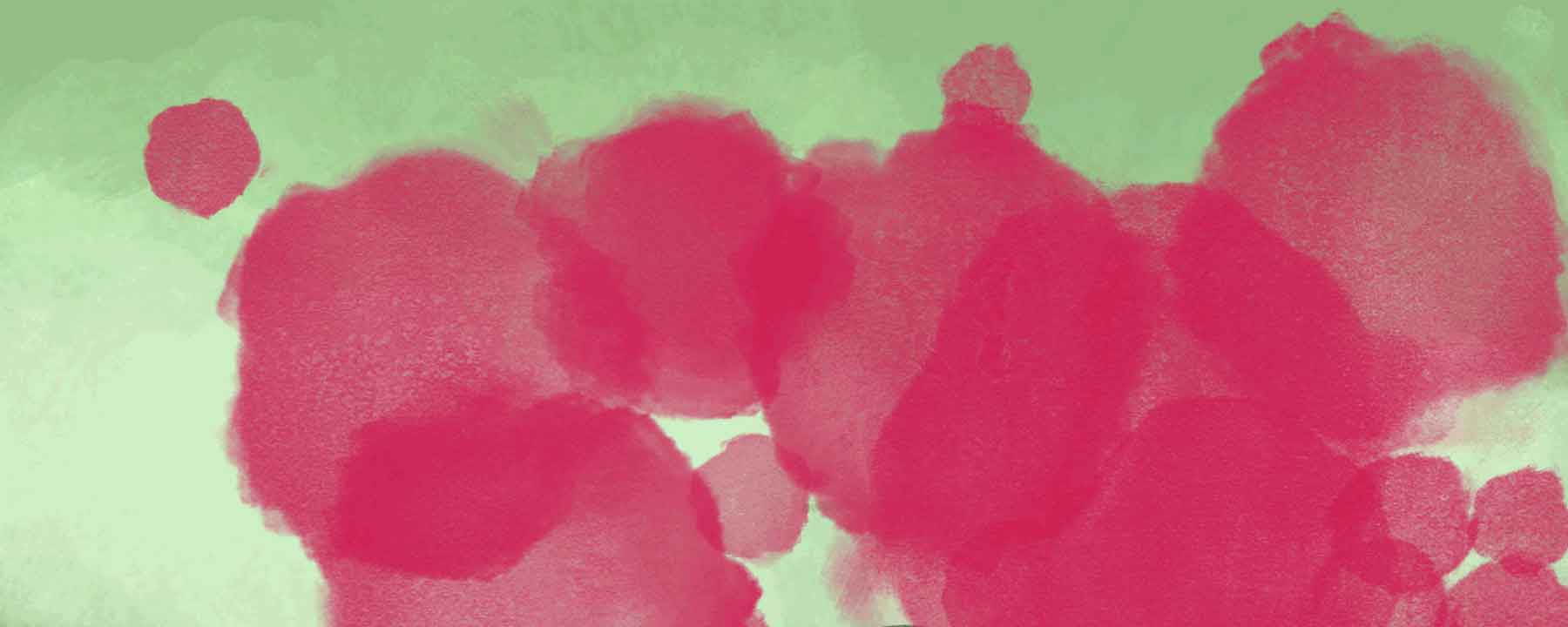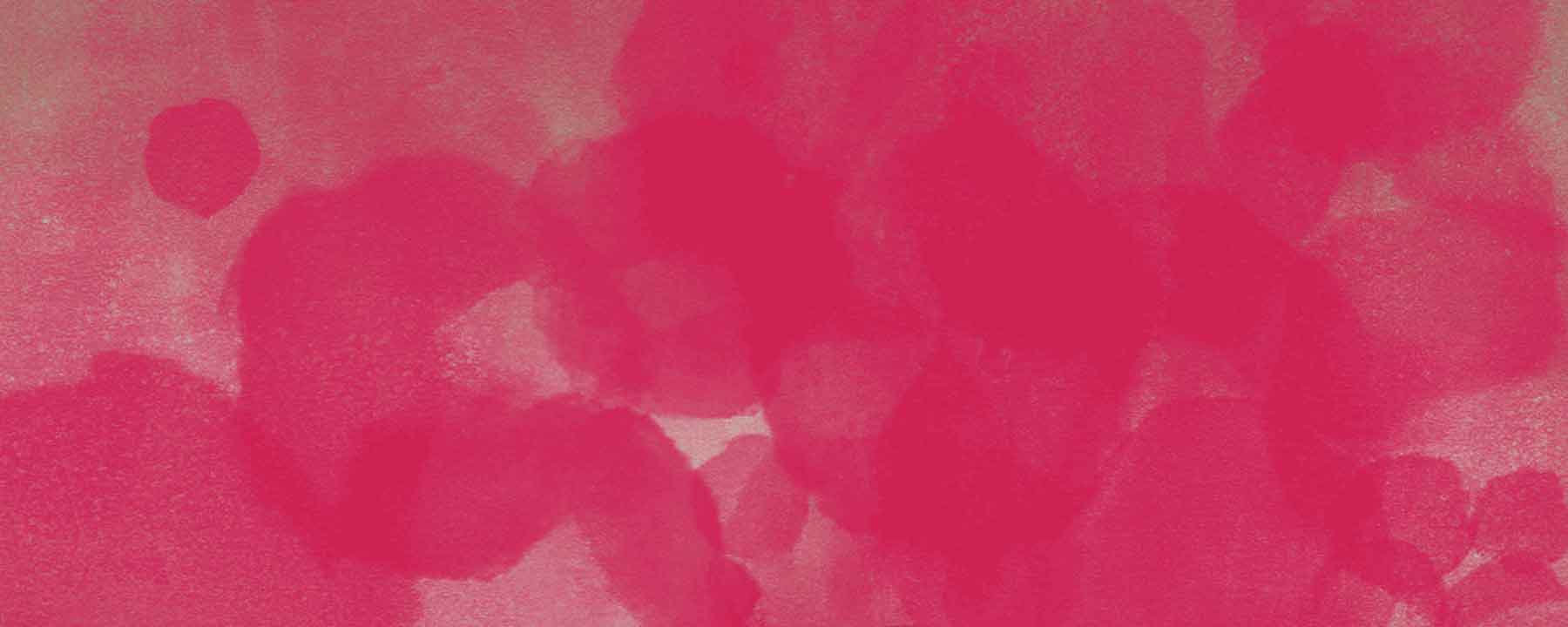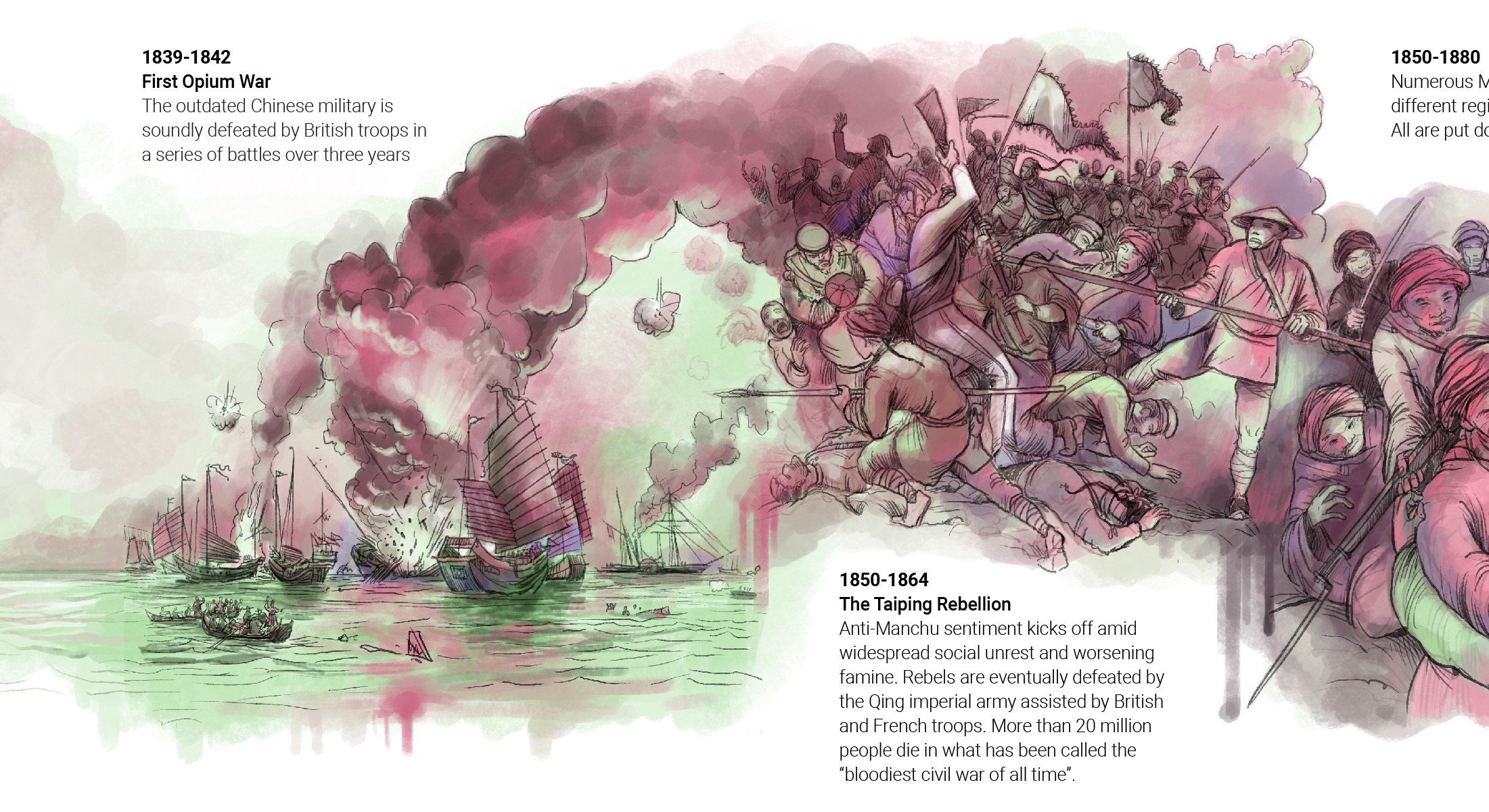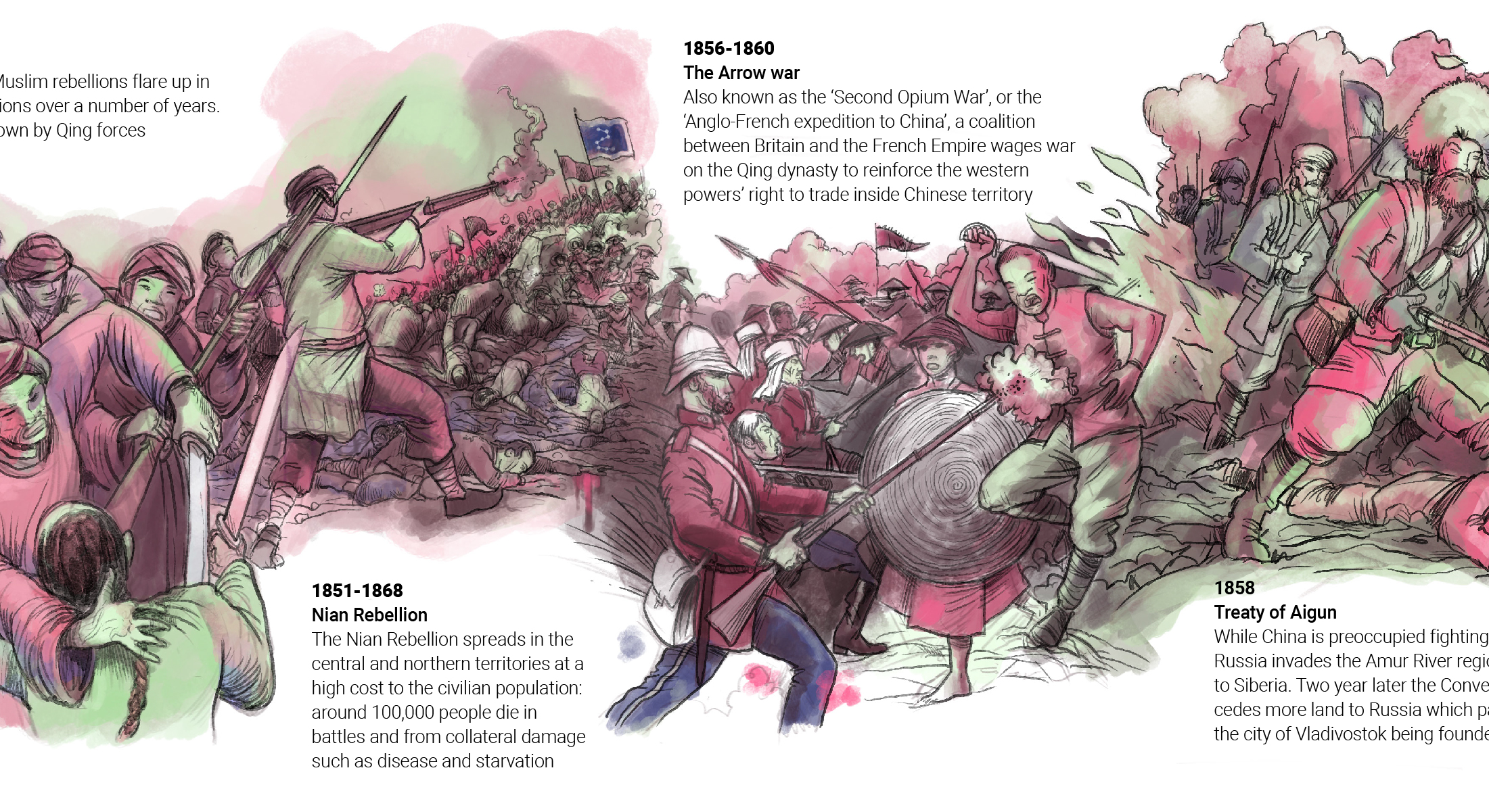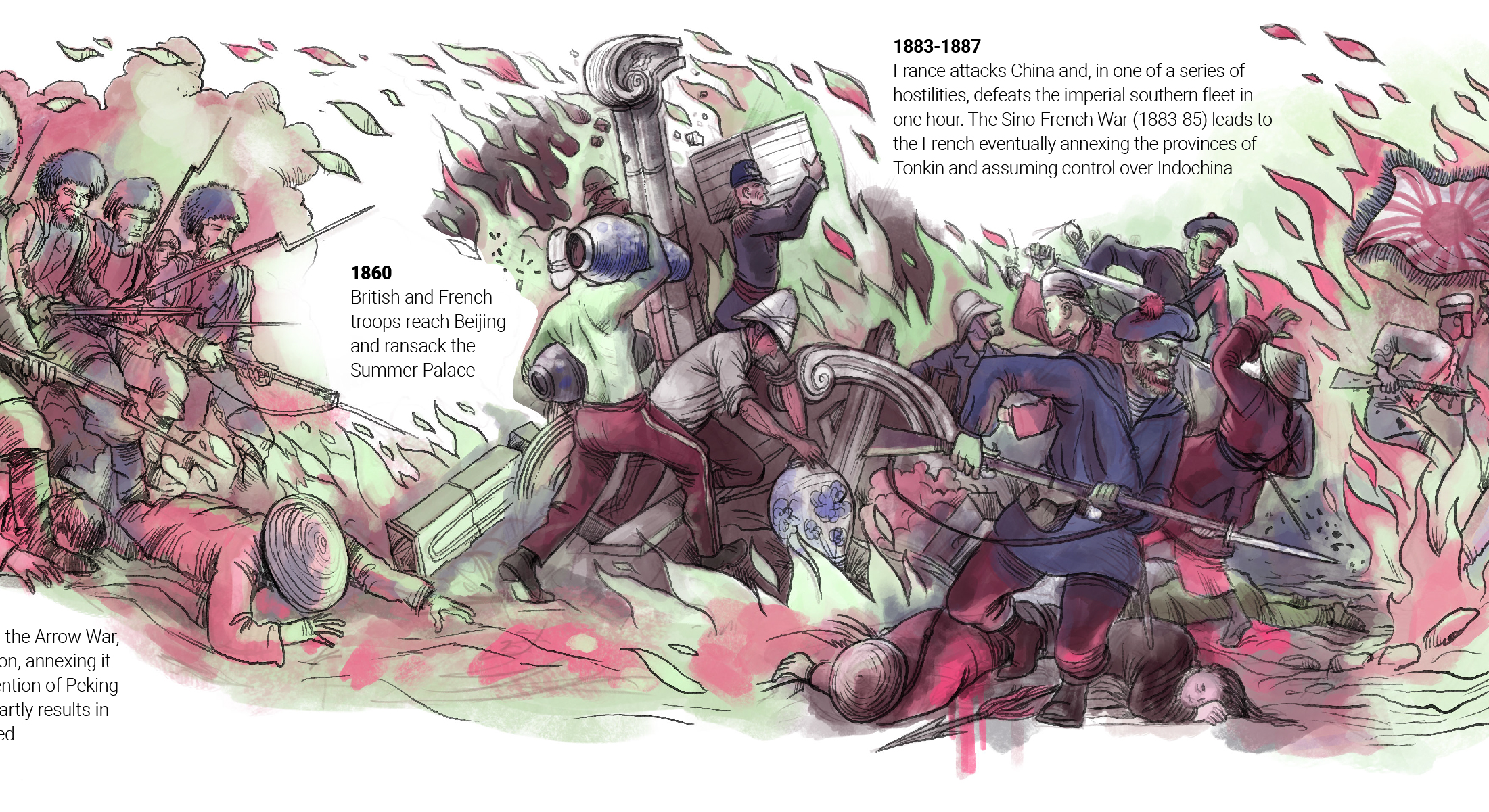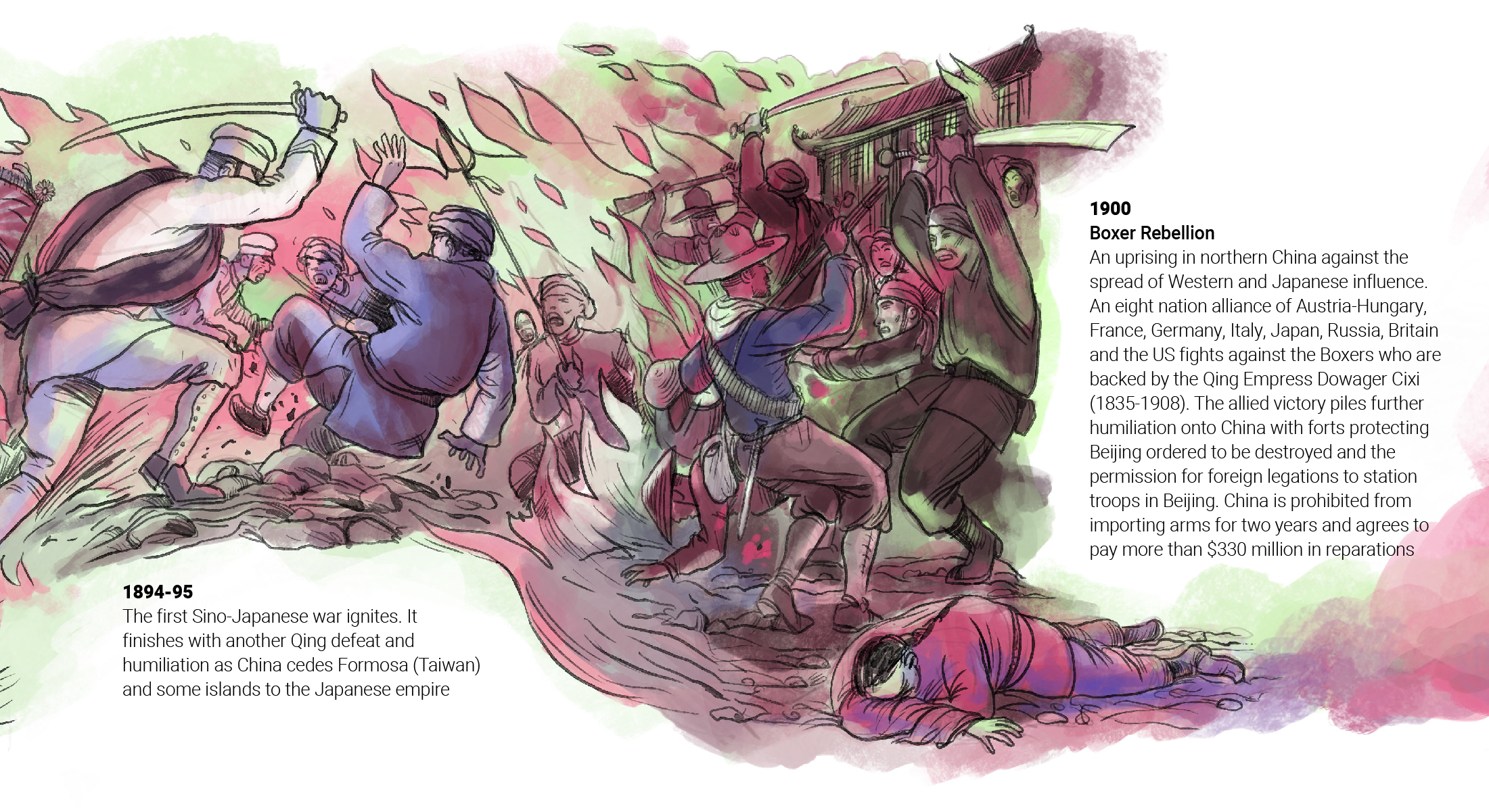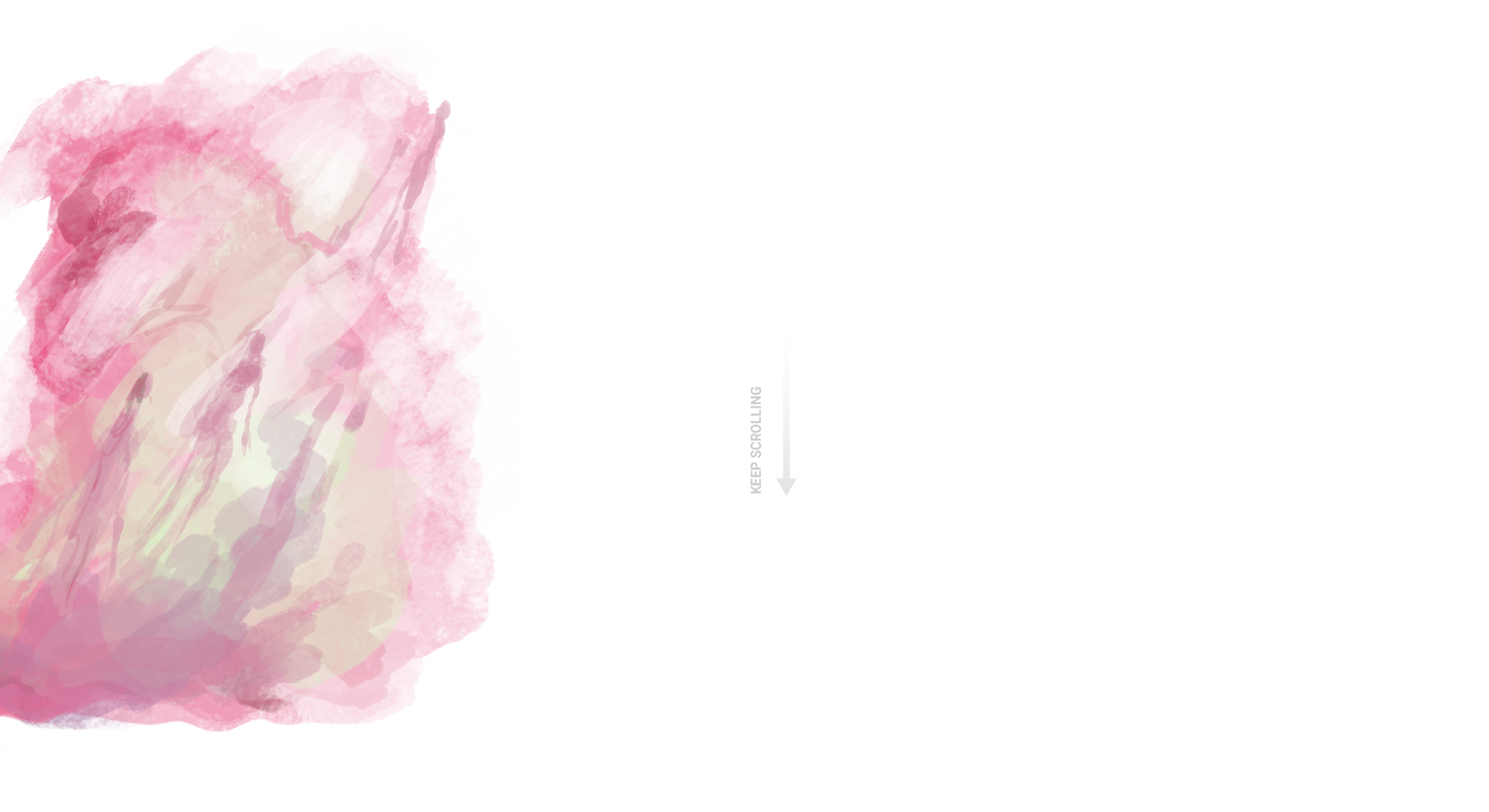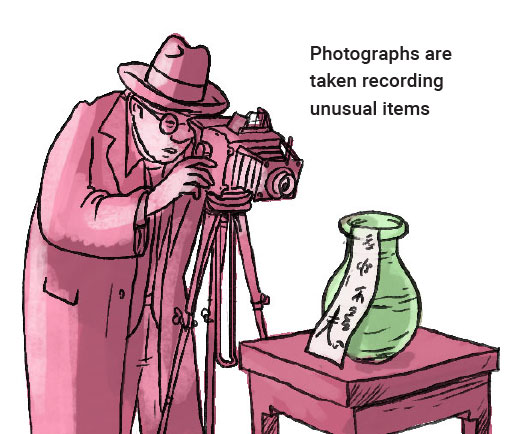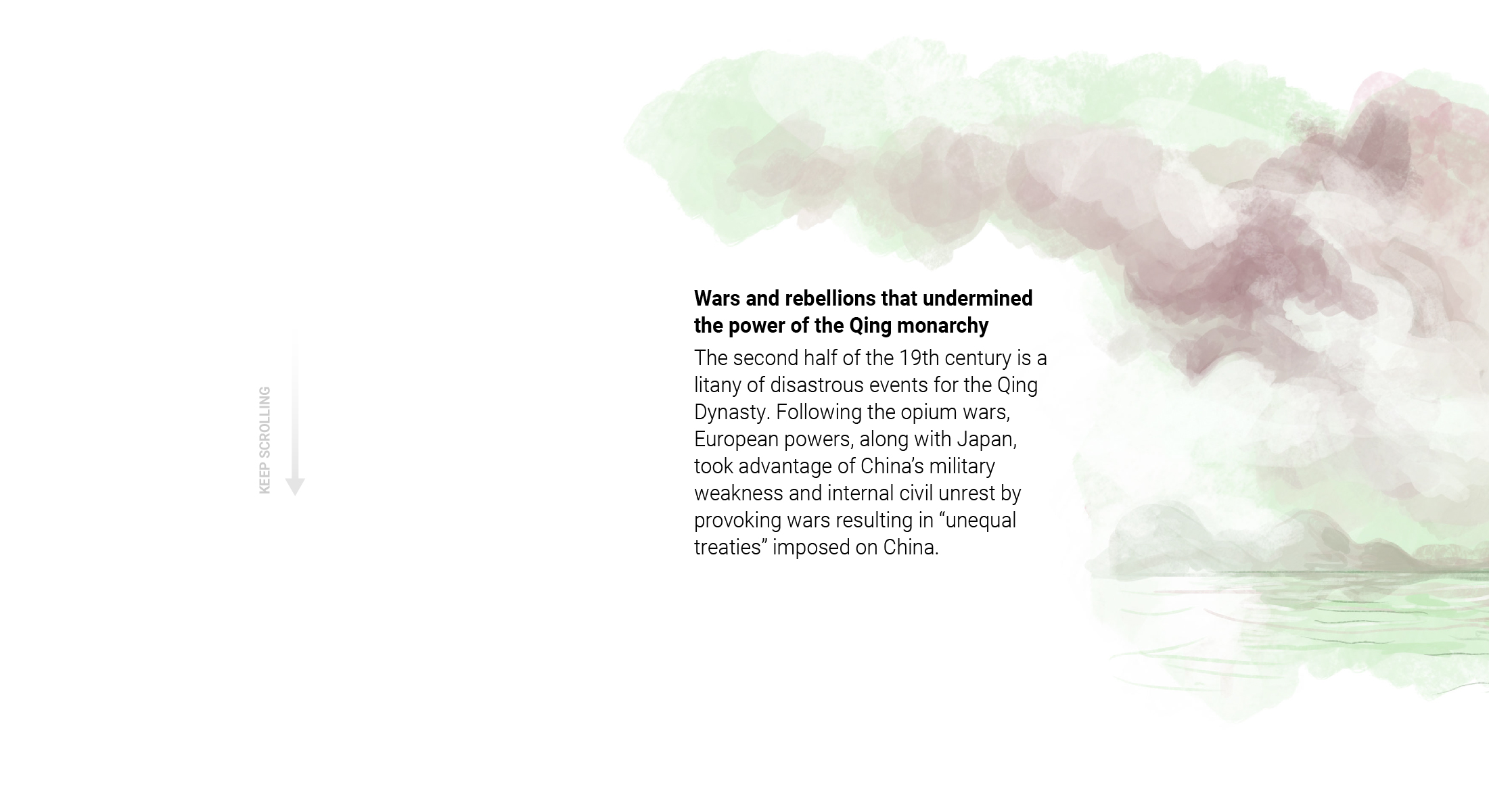
From palace to museum
CHAPTER 1
How China’s Forbidden City became the Palace Museum
A PREVIOUS VERSION OF THIS GRAPHIC WAS PUBLISHED ON DECEMBER 05, 2018. IT HAS BEEN UPDATED AND WAS REPUBLISHED ON OCTOBER 10, 2025.

Adolfo
Arranz
China’s powerful dynasties were all but impregnable to outside influence for more than four millennia.
However, in the 19th century, an inward-looking Chinese empire became the master of its own destruction
when the regime failed to reform and modernise. The imperial system collapsed at the start of the 20th century.
The Forbidden City, which had been home to numerous emperors and housed the world’s greatest collection of art treasures,
was then turned over to the public and transformed into the Palace Museum.
Legacy
China was ruled by imperial dynasties for four millennia. Each successive leader contributed a unique stamp on the country’s rich and complex cultural heritage. For the last two millennia, emperors constantly strove to outdo their predecessors by amassing even greater collections of art, relics, libraries and treasures. Tragically, despite their immense value, these priceless collections were not exempt from the ravages of time, nature, war and looting.
CHINA’S DYNASTIES TIMELINE
- Feudal dynasties
- Imperial dynasties
- 2500BC 2500BC
- 2000BC 2000BC
- 1500BC 1500BC
- 1000BC 1000BC
- 500BC 500BC
- 0 0
- AD500 AD500
- AD1000 AD1000
- AD1500 AD1500
- AD2000 AD2000
-
Xia
-
Shang
-
Zhou
-
Spring and Autumn, Warring States
-
Qin
-
Han
-
Three Kingdoms
-
Jin
-
Five Hus and Sixteen States
-
Northern and southern dynasties
-
Sui
-
Tang
-
Southern Five Dynasties and Ten Kingdoms
-
Song
-
Liao
-
Western Xia dynasty
-
Jin
-
Yuan
-
Ming
-
Qing
From ancient Bronze Age oracle bones to works of art from the early 20th century, China’s emperors and rulers used art to project their legitimacy, wealth and power throughout their dominion.
The collections were incredibly diverse, including paintings and calligraphy dating back to the seventh century, porcelain from the Yuan and Song dynasties, gold and silver ornaments, religious statues made of bronze and gold, rich textiles, architecture, books and documents.
Many Chinese emperors became passionate sponsors, connoisseurs, and authorities on art. Some, such as Huizong Emperor, one of the most famous rulers of the Song dynasty, even contributed their own artistic prowess to disciplines like calligraphy, poetry and painting.

Cast bronze ritual wine vessel from the Shang dynasty (1600-1050BC).
Symbols of power were strategically transferred between dynasties to add legitimacy to each new ruler’s claim. For example, the bronze ritual vessels containing oracle bones from the Shang dynasty were treasured by every subsequent dynasty and venerated as emblems of political authority.
When the Forbidden City was built, emperors surrounded themselves with artisan entourages. They continually commissioned original works and sequestered objects of artistic merit from across the empire, amassing a superlative hoard over many generations.
The two final dynasties amassed works of art on an unprecedented scale and invested heavily in the preservation and curation of the imperial collection
The last imperial dynasty
The Qing dynasty (1644–1911) was founded by the Jurchen Aisin Gioro, a Manchurian clan, who established their power by capturing the Ming capital in Beijing in 1644. It took them several decades to fully subjugate the entire Chinese territory.

Manchu troops passing through the Great Wall of China’s Heaven Gate and heading to Beijing.
Rigid rulers ...
The Qing rulers governed the ethnic Han majority with an iron fist, imposing harsh laws and isolating themselves from the general population.
Han men were forced to adopt the Jurchen hairstyle, which required shaving the front of the head and braiding the remaining hair into a pigtail,
or queue. The queue signified Han submission to Manchu rule and served as an easy way to identify those who refused Qing dominance. Incidentally,
the queue was also an expedient way to clasp a prisoner facing execution.
Perhaps unsurprisingly, the majority Han population continued to regard the Qing dynasty as a foreign monarchy
... and enthusiastic patrons of art
Once their political hegemony was established, the Manchu rulers sought to seal their legitimacy as Confucian-style rulers.
They assimilated Chinese aesthetics and art, guided by servants from the former Ming dynasty. Orders were discharged to workshops
throughout China to supply the court with luxurious products, and within just 40 years, they established 27 workshops inside the Forbidden City.
Qianlong: the great collector
The apogee of splendour during the Qing dynasty was achieved in the reign of the Qianlong Emperor (reign 1735–1796). As one of history’s most important art and literature collectors,
Qianlong sponsored a massive search for ancient written works. More than 5,000 emissaries were commissioned to locate every book of importance in China.
These were transcribed into a monumental encyclopedia called the Siku Quanshu (Complete Library in Four Sections). The final encyclopedia contains an annotated catalogue of
10,680 titles and a compendium of 3,593 titles. Qianlong also personally hoarded more than 15,000 calligraphy works and paintings. A cultured ruler, Qianlong inherited a thriving
empire which he guided to its most splendid and prosperous era, even expanding dynastic territory into Central Asia. However, in his later years, the empire fell into decline due to
corruption and court wastefulness as civil society began to stagnate.

The Qianlong Emperor was not only a prolific art collector but also a passionate poet.
Decline
The Qing empire’s prosperity fueled a massive population boom, which surged from 100 million to nearly 450 million people by the end of the dynasty. However, this growth, combined with taxes and government revenues fixed at low rates, contributed to a severe fiscal decline and the loosening of imperial control. Further weakening the state, an economic recession struck, partially driven by the new trend of trading in silver which eventually led to the Canton System.
Corruption and failure to modernise
A sense of complacency and chronic shortage of funds resulted in the Qing rulers failing to modernise their armies and check the rampant internal corruption of administration officials.
Corruption deepened, revolts broke out sporadically from the mid-18th century onward, and an inward-looking ruling class failed to recognise a fast-changing world order.
These calamities culminated in the collapse of the Chinese empire in the early 20th century.
Nineteenth-century European and American markets had an insatiable appetite for Chinese goods. The resulting trade imbalance led the British East India Company to flood China with opium. When the Qing government banned the drug and attempted to limit the exploits of British merchants, Britain responded aggressively, a policy that led directly to the First Opium War.

Opium dens spread rapidly throughout China, posing a grave social threat and causing great concern for the imperial authorities.
The modern, well-trained and battle-hardened British forces easily crushed the numerically superior, but poorly supplied, Qing troops. This forced China’s surrender and the signing of the Treaty of Nanking in 1842 . This unprecedented military humiliation saw Britain force Beijing to cede Hong Kong in perpetuity, pay indemnity of 21 million silver dollars and grant the right to trade at five treaty ports. For the first time in thousands of years, China looked vulnerable to foreign ambitions, and the ruling dynasty was now perceived as weak by the Chinese population.
The Xinhai Revolution
The accumulation of chastening defeats spurred strong anti-Qing sentiment among the population. The imperial government attempted reforms, but they were seen as insincere and poorly implemented - it was too little, too late to save the ailing dynasty.
In 1905, Dr Sun Yat-sen, exiled in Japan, founded the Tongmenghui (Revolutionary Alliance), bringing together many anti-imperial organisations. A series of revolts gradually spread throughout China. Although the authorities were able to quell these uprisings, the Qing dynasty continued to be undermined while the rebels grew ever more popular.

In 1908, the state lost its two most powerful figures when the Guangxu Emperor and Empress Dowager Cixi died on November 14 and 15, respectively. The emperor’s two-year-old nephew, Puyi, was named his successor, leaving his father, Prince Chun, as regent of a collapsing empire.
On October 10, 1911, three years after the death of the Dowager, the Xinhai Revolution (also known as the ‘1911 Revolution’) broke out against the Manchu rulers. Spreading rapidly from province to province, the Qing monarchy fell in just four months. After thousands of years of absolute power, the final dynasty capitulated, barely offering any resistance.

The Battle of Yangxia was the decisive event of the Xinhai Revolution. Its successful 41-day resistance against the Qing dynasty encouraged other provinces to join the revolution.
The government of the new republic confined the five-year-old heir, Puyi, his family, and a large retinue of eunuchs, to live under virtual house arrest within the Forbidden City.
The new era
PUYI REMAINS IN THE FORBIDDEN CITY
The new republican government allowed the young, deposed emperor, Puyi, to remain in the royal palaces. His family, dowager consorts,
and a large cohort of eunuchs stayed with him, retaining their former privileges within the confines of the Forbidden City.
After signing the abdication, the ownership of the deposed dynasty’s treasures was uncertain:
it was not immediately clear whether they belonged to Puyi or became the property of the state.

An agreement between the Qing dynasty and the republican government eventually led to treasures from four summer palaces being transferred back into the Forbidden City. By 1914, many state officials began considering whether the imperial treasures should be displayed as a national collection inside the Forbidden City itself.
In 1919, Puyi was assigned a Scottish diplomat, Reginald Johnston, as his tutor and adviser. Johnston lived in the Forbidden City and the New Summer Palace, forming a very close relationship with his pupil.

The Forbidden City's maintenance remained the financial responsibility of the Manchu family. When government grants stopped being paid regularly, Puyi began selling some of the palace treasures to cover his personal expenses for the upkeep of the property.
SMUGGLING OBJECTS
In 1923, Puyi began the laborious project of making a complete inventory of the palace collection. When many known pieces could not be located,
he decided to inspect the Palace of Established Happiness, where the Qianlong Emperor had stored his favourite items.

The palace eunuchs, long adept at corruption, had been smuggling these treasures out of the Forbidden City and selling them to collectors in Beijing. Alarmed by the prospect of their plunder being discovered, the eunuchs set fire to the Palace of Established Happiness.

The fire devastated the building. Of the 6,643 items that had been inventoried long ago, only 387 were rescued. Porcelains, ancient bronzes, Buddhist paintings, innumerable books and countless priceless objects were lost forever.
6,643 items stored at the Palace of Established Happiness
Realising the eunuchs’ actions, Puyi expelled them from the Forbidden City, retaining only a small number to care for the older consorts. Notably, after this expulsion, many antique stores run by former eunuchs sprang up in the Tiananmen neighbourhood.

When the government subsequently began its own exhaustive inventory, Puyi grew alarmed that the state was moving to assume ownership of the collection. He decided to begin pillaging numerous objects himself with the help of his brother, Pujie.
Pujie, who lived outside the Forbidden City but came to study inside every day, smuggled out objects and paintings when he returned home in the evenings.

To avoid suspicion, Pujie smuggled out historic books by hiding them in brocade wrapping, the customary packaging for standard textbooks.
Objects smuggled by both brothers
HANDSCROLLS
1,285
RARE BOOKS
200
PAINTING ALBUMS
68
CALIGRAPHY ALBUMS
23
The Qing expelled
On November 4, 1924, the new republican government changed the law, declaring the Forbidden City to be public property.
The government ordered the expulsion of the Qing imperial family from the palace. The Qing were permitted to take only
their personal belongings; all remaining treasures and historical objects were declared the property of the state.

The birth of the Palace Museum
Just two days later, on November 6, 1924, the State Council organised a special committee to manage the disposition of the imperial possessions and take custody of the public property. An exhaustive inventory and audit began immediately, with the expressed intention of proclaiming the Forbidden City a national museum to house the imperial collection.
Experts were brought in to decide whether an object was public or private property:
THE GREAT AUDIT
The inventory-taking process and staffing:
The inventory classified the treasures into major categories, ranging from sacrificial vessels of the early dynasties to paintings, calligraphy, jade objects, and countless books and documents.
The final archive was registered in 28 volumes containing
0 items
Among these were standout categories:
-

Sacrificial vessels and jade
Ding Cauldron of Duke Mao (Late Western Zhou dynasty, 1046-772BC). -

Painting and calligraphy
Bu Shang Studying, Running Regular Script, by Ouyang Xun (557–641). -

Porcelain
Mallet-shaped celadon vase with two phoenix-shaped handles (Southern Song period, 1127–1279). -

Enamel and lacquerware
Champlevé Enamel Zun Wine Vessel in the Shape of an Ox -

Gold and silver ornaments
Gold ruyi sceptre engraved with floral designs. -

Antiques (bamboo, wood, etc.)
Bamboo root carving of longevity deity riding a deer (Qing dynasty). -

Religious statues
Gold Statue of Maitreya with Pearl Inlays (16th century). -

Robes, textiles and furniture
Emperor’s ceremonial armour (Qing dynasty, Yongzheng period). -

Books and documents
Collection of calligraphic works by Zhao Mengfu in running script.
The Palace Museum was inaugurated with much fanfare on October 10, 1925 - the Republic of China’s National Day. The opening ceremony was held at the Gate of Heavenly Purity (Qianqingmen Gate) and was a huge success, with more than 20,000 people attending. The Forbidden City formally ceased to be an emperor’s palace.

Despite the hopes and aspirations for the new institution, increasing political instability once again plunged the future of the Forbidden City into uncertainty.
The Palace Museum
By the South China Morning Post graphics team
-
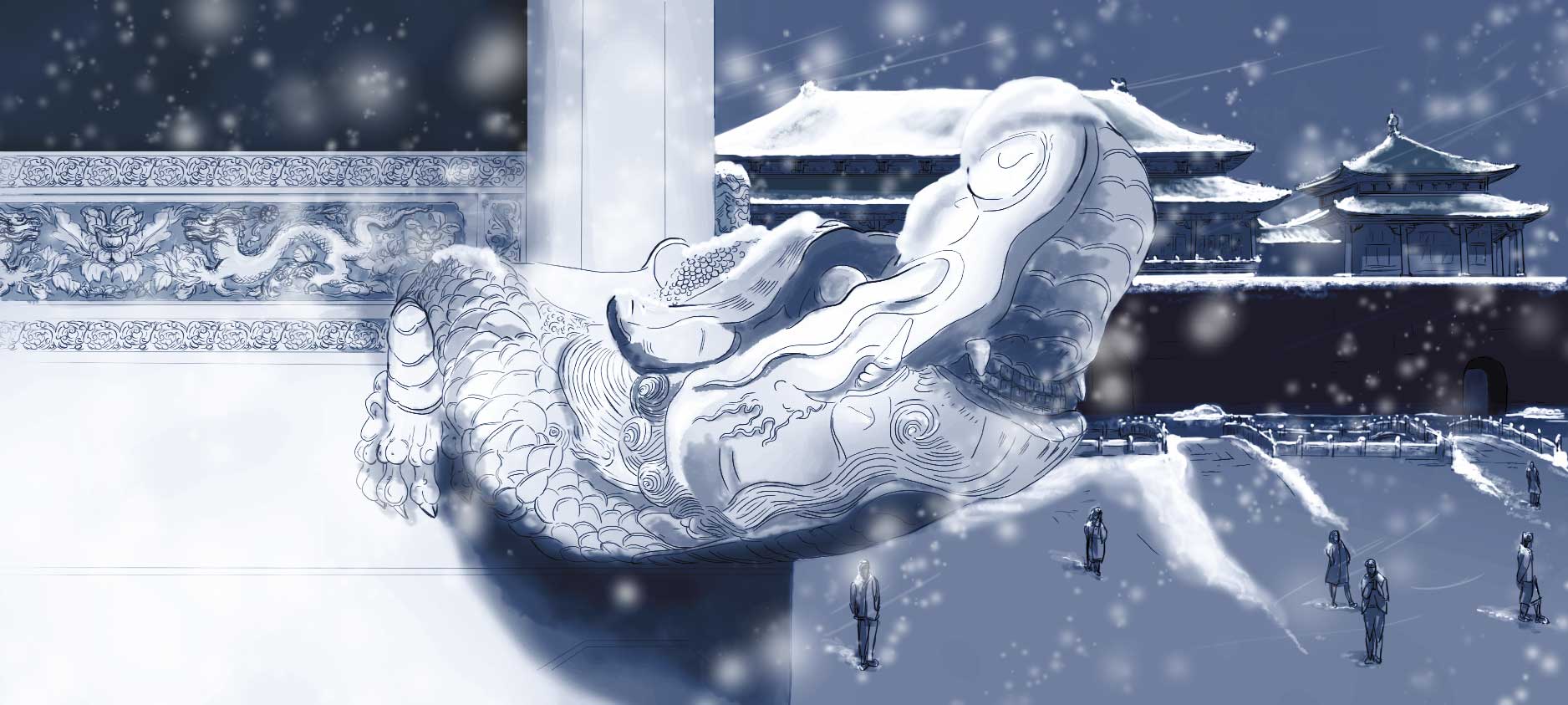
I
PARTThe Forbidden City’s unique architecture
By Marco Hernandez
-
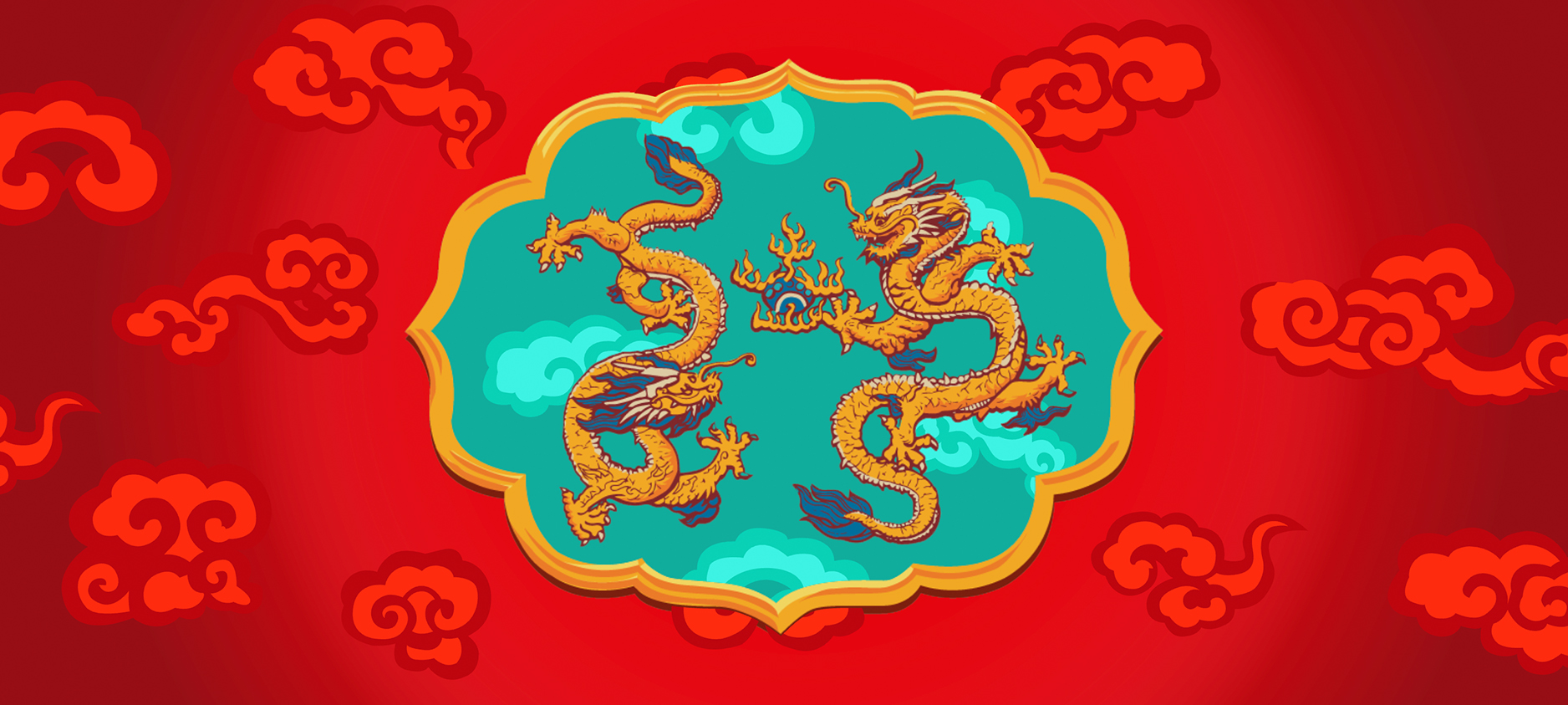
II
PARTLife inside the Forbidden City
By Marcelo Duhalde
-

III
PARTThe collection, the odyssey of the objects
By Adolfo Arranz
- Chapter 1
- Chapter 2
RELATED STORIES
Hong Kong Palace Museum to feature 100 textiles celebrating Chinese silk culture
Hong Kong exhibition explores cultural exchange between China and Mughal courts
Hong Kong Palace Museum’s Special Exhibition “The Hong Kong Jockey Club Series
Hong Kong Palace Museum’s Egyptian exhibition ‘just the start’ of collaborations

